France Foray e-Postcard #1
from Our Journey to France
May 19 to May 23, 2014
Bonjour (or Bonsoir, if it is evening) Everyone --
As you may know, we are traveling in France with four friends and so we are sharing our random travel thoughts with you. The first few days was spent by ourselves in the mid western coast of France, primarily Brittany. Why there? It is the land of rugged coastlines, lighthouses, seafood, small villages, Neolithic monuments as well a few well know tourist sites. Not to mention opportunities for endless photographs.
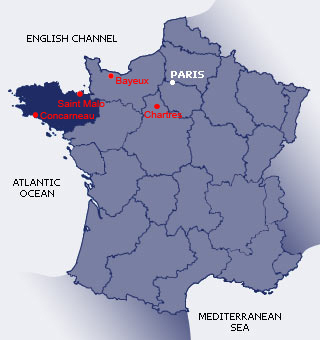
BAYEUX or "everything goes better with cider"
Armed with a large stuffed duffle bag, two backpacks, three cameras, numerous converters and chargers, a GPS (with French maps), one dictionary, one menu translator (no sheep innards for us), and four years of French (20 years ago by Di) we headed to Paris from Detroit. We quickly found the rental car office, only to wait almost an hour to get out on the road in our small, manual transmission vehicle. Our GPS (fondly named Carmen, but sometimes called by other unmentionable names) had been preprogrammed to whisk us from the airport to our first stop, Bayeux. She tried her hardest, pronouncing those French road names in English. But one could easily spend eternity trying to drive out of Paris, as the multiple lanes, confusing signage, and motorcyclists who ignore lane markers add to the stress (um, I mean, sense of adventure).
Eventually we made it into the lovely French countryside. It is as you have pictured it: small villages and chateaus nestled in the rolling hills of green fields. There was a surprising lack of billboards and factories once you are outside the big cities. The common feature to all types of French roads (except the tollways) is the ubiquitous roundabout, that circular road that replaces stoplights and allows several streets to intersect at one place. Some were so small that you hardly noticed the bump on the left side as you blissfully drove over them or circled the town fountain or main town square. Others were so large you lost sight of the other side and depended on the signage (usually good) and the mercy of other drivers (usually nonexistent) to find the way out. Exiting a roundabout at the wrong place (more than once), making a U-turn, and returning to the roundabout must have made a lovely aerial pattern like the petals of a daisy, but we failed to appreciate that.
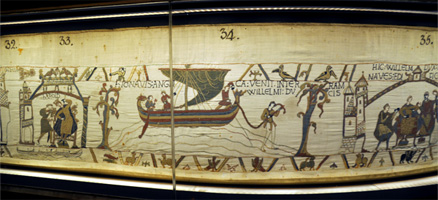
Bayeux (pronounced incorrectly too many ways) is the largest town near the D-Day beaches of Normandy. We came here primarily to view the Bayeux Tapestry, a 68.3 meter (224 feet) long embroidery depicting how 11th century folks lived through the events leading up to the Battle of Hastings in 1066. It has colorful and intricate stitching, but has a sort of comic book look to it. You can (with the help of the audio guide) see how the ambitions of the elite involved the common folk on both sides, the Saxons and the Normans. Those who worked on the tapestry had incredible talent and patience, a great sense of humor (facial expressions on people and horses) as well as history (battle details and the sighting of Haley's comet).
This was the first of several places where photography was prohibited, as shown at the museum entrance by a picture of a camera with a line through it. However, that didn't stop those with cell phones and ipads from taking photos. I guess they thought if it wasn't really a camera, it was okay. Obviously, this riled Tim. One of the covert, illegal photos of the tapestry is attached.
Other places of interest to us in Bayeux included a small lace workshop (the area was famous for its intricate handmade lace) and the first of many Notre Dame cathedrals (any self-respecting town has one). Dinner was traditional Norman including galettes (a crepe made of buckwheat flour filled with local meat/cheese) and hard cider. The latter, called cidre, has been made here for centuries with much of it bottled at small orchards nearby. It is alcoholic and ranges from dry to sweet, like wine. I think if the subjects of the Bayeux Tapestry had imbibed more cidre together, they would have been friendlier and the tapestry would have been much shorter.
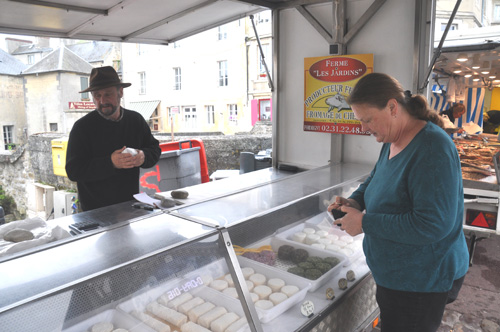
We stayed in a small hotel in the old city. The entrance was a single door hidden among shops, but it led to a courtyard surrounded by the guestrooms and the owners' home. Our room was small but comfortable. The surprise was the shower. It was rectangular with half the floor below the water spray area and the other half empty. There was no shower curtain, so you had to aim that shower head so that you didn't flood out the rest of the bathroom or break your neck sliding on the empty half. We saw this several times in French hotels. Who thought we would get to practice acrobatics in a French bathroom?
Breakfast was lovely with local apple juice, cheeses, jams, pastries, and fresh baguettes (the first of hundreds this trip) served by a woman whose English was far better than our French. She suggested we visit the local street market before leaving. We bought a rather large fresh goat cheese coated in peppercorns (yum) which ended up on sandwiches the next two days.
DRIVING A CAR IN FRANCE or random rules of the road
It is time to take a few moments to examine some quirks (I mean, rules) of French driving. Having already mentioned roundabouts, let's add that the theory is you stay in the left lane until just before you are ready to turn right.
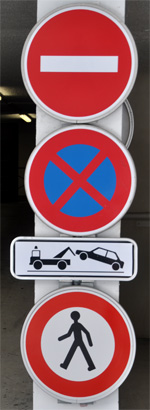 This should allow those getting off on previous exits time to clear that right lane. Ha! It is a virtual free for all as you jockey your way to the proper exit, never knowing if you are entering a two lane exit or about to be cut off by a motocycle or bus. This is a prime example of "he who hesitates is lost" or at least must circle again to get nearer the exit. This is especially harrowing as your GPS states "take the second exit to mumble, mumble, mumble", your map says D35 and the sign says A63/E7. The city you are heading for has a 50/50 chance of actually appearing on the signage.
This should allow those getting off on previous exits time to clear that right lane. Ha! It is a virtual free for all as you jockey your way to the proper exit, never knowing if you are entering a two lane exit or about to be cut off by a motocycle or bus. This is a prime example of "he who hesitates is lost" or at least must circle again to get nearer the exit. This is especially harrowing as your GPS states "take the second exit to mumble, mumble, mumble", your map says D35 and the sign says A63/E7. The city you are heading for has a 50/50 chance of actually appearing on the signage.
France has a law of "priorité à droite". That means any car entering the intersection from the right has priority. This includes alleys, parking lots, and driveways unless the area is marked by a "upended square" (aka diamond) with a line through it. Clear? Yeah, we don't fully understand it either. But obviously the trucker who honked at us as we blissfully drove in front of him does know the law. Also, white parallel lines across the road means you must stop there for pedestrians. I think they lie in wait for us to come up a steep hill and get very close to the crosswalk before stepping into the street. Recall that we have a stick shift. Motorcycles don't always follow this law. We saw one nearly take out a lady in a wheelchair!
Speed limits change frequently and are indicated by the word "rappel" (meaning "reminder") and a number. It is assumed you already know the speed limit and are just being gently told again. The signs for no parking, limited parking, one way, no entry and entry only at certain times look a lot alike when you are in narrow streets or in front of perturbed locals. Tim certainly had lots of practice backing up and making U-turns. The town folk probably wondered why the same car of tourists kept coming by from different directions. Also, beware if you set your GPS to "fastest route" rather than "shortest route". Due to the roundabouts and one-way streets, the fastest route often takes you through very tiny villages containing nothing but a few houses and barns set dangerously close to the road. At times we were in such remote areas that Carmen could only say "turn left at ROAD" as the road had no known name.
MOUNT SAINT-MICHEL TO CONCARNEAU or "so many lighthouses, so little time"

We had only three days left before we were to meet the group in Paris, so we hightailed it to the world-famous Mount Saint-Michel, located in Brittany. This abbey/fortress/former prison and accompanying village rises from the sea on an island, accessible originally only during low tide (which can vary as much as 15 meters or almost 50 feet). Although now there are buses, a walkway and a future bridge to connect it to the mainland, its majestic towers still inspire. It is, unfortunately, a much visited tourist spot and throngs of folks walk the spiral road to the abbey at the summit, surrounded by restaurants and souvenir shops.
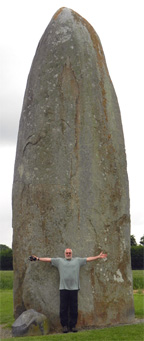 At the top, however, it was just the stone walls, the sea, overcast skies and views of the coastline. We didn't visit the abbey itself, but could easily see why this area has attracted religious pilgrims, invaders from England, and foreign visitors since it was first built starting in 708 AD.
At the top, however, it was just the stone walls, the sea, overcast skies and views of the coastline. We didn't visit the abbey itself, but could easily see why this area has attracted religious pilgrims, invaders from England, and foreign visitors since it was first built starting in 708 AD.
One of our traveling goals is to see any ancient stone constructions in the areas we visit. From Stonehenge to Australian rock carvings to the rock paintings of the American Southwest, we will go out of our way to find a dolmen (stone tomb), menhir (standing stone), cairn (burial mound), or pictograph (painted or carved picture). Brittany is a virtual treasure trove of such things. On our way to Saint-Malo, a walled coastal town, we stopped at the Menhir de Champ Dolent. The key word here is "champ" as this single stone is 9 meters (almost 30 feet) high and stands alone surrounded by flat land. Who knows how it was moved or why it is there, but it was truly impressive. Later in the trip we would see many menhirs, but this was the tallest.
Dinan is a nearby town that has maintained its medieval past with its cobblestone streets and crooked half-timbered houses whose second story hangs out over the street. Tim took pictures under threat of rain from the 15th century belltower while Di bought Breton (from Brittany) caramels to support the local economy. When we reached our hotel in Saint Malo, we found that it had a new owner and we were put into a different hotel. No worries, it was located very close within the walled old town and had a great view. The underground parking was at the end of a seriously steep and narrow spiral. It tested Tim's driving abilities (and resulted in a slight bumper scratch on the way out).
We walked the top of the walls (12th century) and around the city, despite the (still) overcast skies, enjoying views of the English Channel . In this port city, the elite were the trading merchants and the government sanctioned pirates (called corsairs). It is always eye-opening to realize that the oldest (non Native American) buildings in the U.S. may be from the 17th century, while in Europe they can be well over 500 years older.
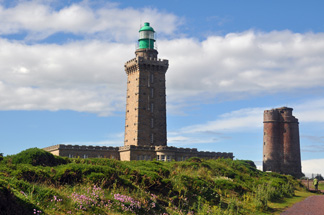
Winding roads, rainy skies and roundabouts can certainly curtail an optimistic agenda. Our trip all around the Brittany coast was to include several lighthouses, more Neolithic formations, and rocky outcrops. As we headed from the mighty Cap Frehel lighthouse along the Cote de Granite Rose (coast of the pink granite), we realized we would have to cut out a lot of anticipated sights. Bypassing entire peninsulas allowed us to focus in on the remaining two lighthouses and some alignments (long lines of smaller standing stones). Carmen, the GPS, happily took us down back roads to Pointe de Espagnol (which Carmen called pointy dee ess pag nole). We never found it or its view of a lighthouse. So, off to our night stay in the harbor town of Concarneau. Its lighthouse was puny, but provided a photograph nonetheless.
Since Brittany is famous for its oysters, scallops and fish, we thought this might be a good evening for a seafood dinner. But the long drive and endless rain (as well as the high prices) drained us of our energy so we settled for Indian food!
CARNAC or "getting stoned in France"
One of the highlights of our trip was the visit to Carnac, on the southern coast. Although the town itself is small, it has one of the largest collections of Neolithic stone formations in the world. Some of them are 100 years older than Stonehenge in England with the heaviest weighing 300 tonnes (over 600,000 pounds. Most of the stones are thigh-high to about 5 feet, but a few are taller than Tim. Looking around the area, you wonder how did the ancients ever carve, move and set these rocks upright 5000 to 3500 B.C.?

Most of the visible stones are along one road, called the Rue des Alignments. There were several areas, each having hundreds (up 1,100 stones) in perfect, long lines--see other attachment. The areas are closed to wandering tourists during the summer (but you could still easily take photos). This means that the fields were dotted with wild flowers among the stones. The overcast skies led a kind of mystical aura to the place. There was certainly a cultural, probably religious, purpose for the tremendous human effort to create these formations. What a shame its meaning is now lost.
CHARTRES or "a blue to remember"
After Carnac, we headed for Chartres which 91 km from Paris. Known for its glorious 13th century cathedral (another Notre Dame) which has two different spires, one Gothic and one Romanesque. The outstanding feature is its 172 incredible stained glass windows, including two huge rose (round) windows. Even on an overcast day, the colors take your breath away. The intensity of the blue tone made that color famous worldwide as "Chartres blue". Di's sister Michele (an artist) says she can close her eyes and see that color in her dreams.
We stayed right next to the cathedral in a former monastery, now used for retreats and as a guest house. The guest house was located inside the pedestrian center of the old city and we were sent a map to guide us through the police kiosks to our place. Carmen took us right to the blocked off road we were to take so we drove aimlessly until we saw road with a small stand (like the order kiosk at McDonalds) on the side. We were supposed to drive up, give our name and hotel to the police person who answered, and they would lower the large metal cylinder blocking the entranceway to the inner city.
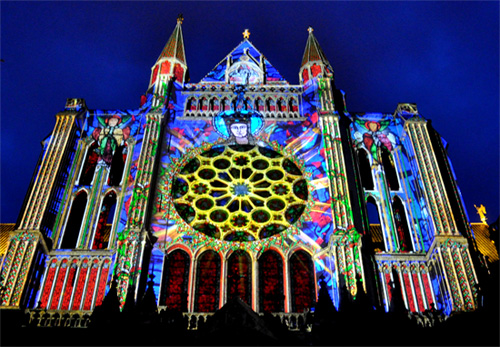 Three times we tried different kiosks, with the cop at the other ending saying "Monsieur, this is not the place, you can't come in." Finally, after an hour, we found a friendly kiosk cop and the hotel (where you had to back in downhill to make it through the gates and into the small parking lot).
Three times we tried different kiosks, with the cop at the other ending saying "Monsieur, this is not the place, you can't come in." Finally, after an hour, we found a friendly kiosk cop and the hotel (where you had to back in downhill to make it through the gates and into the small parking lot).
It was worth it, though (says Di, who wasn't driving). The room was simple (with a contender for the world's smallest shower), without a tv, but the location was perfect. As you walked out the door you could hear a choir practicing. Around the corner was the cathedral and down the block was a restaurant with an outstanding seafood salad. As night fell, we were able to view the Lumieres. You may remember that when we were in Torun, Poland we saw a festival of buildings whose sides became venues for huge videos that reflected the buildings' architectures. In Chartres, there is a similar event which lasts all summer and involves almost thirty buildings, bridges, and the cathedral itself. We saw 16 of these (dragging home at 1 a.m.) but the most outstanding was at the front of the cathedral. It lasted about five minutes and looked like little men building the cathedral stone by stone. The website https://www.youtube.com/watch?v=_OcSt2LzYb4 can give you a short overview of what we saw.
The next morning we went back to Paris to return our car and meet the rest of the group. We'll relate those adventures in the next e-postcard. Let's end with some observations:
- You know your accent is bad when you tell a person "merci" (thanks) in French and they answer "you're welcome" in English.
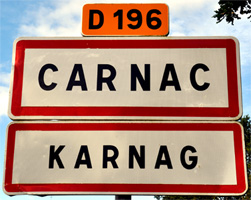
- The French park in any available space, in any direction, if the parking is free. They leave just a few inches between the cars.
- The French equivalent of our "7-11" store is called and 8h (8 hour, except it is open longer than that).
- The bakeries sell a small quiche that makes for quick and yummy eating on the run. We've tried quiche Lorraine, salmon, veggie, and cheese.
- The early settlers here spoke Breton, related to the Gaelic language of Ireland. So, some of the signs are written in both languages. So when we (and Carmen) were looking for Carnac, it was called Karnag. And Vannes is also called Gwened. No wonder all three of us were confused at times.
- We saw a bakery called "L'Instant Pain". It translates as "fast bread" - a speedy service bakery, but we don't think we want to go in anyway.
Au revoir (good bye) and thanks for reading. More on Paris, Lyon, and Mediterranean Coast coming soon.
-- Di & Tim
 This should allow those getting off on previous exits time to clear that right lane. Ha! It is a virtual free for all as you jockey your way to the proper exit, never knowing if you are entering a two lane exit or about to be cut off by a motocycle or bus. This is a prime example of "he who hesitates is lost" or at least must circle again to get nearer the exit. This is especially harrowing as your GPS states "take the second exit to mumble, mumble, mumble", your map says D35 and the sign says A63/E7. The city you are heading for has a 50/50 chance of actually appearing on the signage.
This should allow those getting off on previous exits time to clear that right lane. Ha! It is a virtual free for all as you jockey your way to the proper exit, never knowing if you are entering a two lane exit or about to be cut off by a motocycle or bus. This is a prime example of "he who hesitates is lost" or at least must circle again to get nearer the exit. This is especially harrowing as your GPS states "take the second exit to mumble, mumble, mumble", your map says D35 and the sign says A63/E7. The city you are heading for has a 50/50 chance of actually appearing on the signage.




 At the top, however, it was just the stone walls, the sea, overcast skies and views of the coastline. We didn't visit the abbey itself, but could easily see why this area has attracted religious pilgrims, invaders from England, and foreign visitors since it was first built starting in 708 AD.
At the top, however, it was just the stone walls, the sea, overcast skies and views of the coastline. We didn't visit the abbey itself, but could easily see why this area has attracted religious pilgrims, invaders from England, and foreign visitors since it was first built starting in 708 AD.


 Three times we tried different kiosks, with the cop at the other ending saying "Monsieur, this is not the place, you can't come in." Finally, after an hour, we found a friendly kiosk cop and the hotel (where you had to back in downhill to make it through the gates and into the small parking lot).
Three times we tried different kiosks, with the cop at the other ending saying "Monsieur, this is not the place, you can't come in." Finally, after an hour, we found a friendly kiosk cop and the hotel (where you had to back in downhill to make it through the gates and into the small parking lot).
